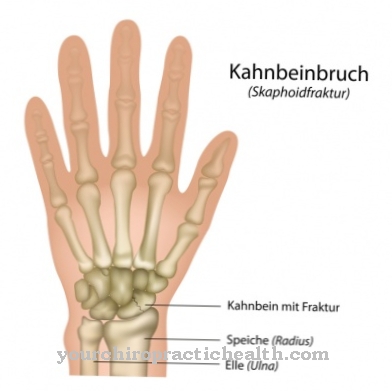The term Dysarthria involves a range of speech disorders. Writing, reading, grammar and language comprehension are not affected. Only the motor skills of speaking are disturbed by impairment of cranial nerves or damage to the brain.
What is dysarthria?

© Reing - stock.adobe.com
Speaking is a highly complex interplay of more than a hundred muscles, the larynx and breathing. When breathing, the diaphragm, as the main breathing muscle, and other breathing muscles ensure that the chest and abdomen are expanded and the air can flow in. When you breathe in, the diaphragm sinks down, creating space for the inflowing air; when you breathe out, it rises again and presses the air outwards.
The incoming and outgoing air is guided over the larynx. It is made up of many muscles and cartilages, and inside are the vocal folds. In order to be able to produce sounds, the vocal folds close and the breath presses against them. They start to vibrate and this creates sounds. These sounds are articulated into words in the mouth and throat. This involves the tongue, lips, jaw, and soft palate.
Head and body posture are important so that all of this can function unhindered. Breath can only flow freely and voice and articulation are not impaired if the upper body is upright and the head is upright.
This power is controlled in the brain. The cerebral nerves transmit the movement impulses to the various muscles and thus create the necessary fine-tuning so that speaking is flawless.
Dysarthria can result from damage to or disease of the brain or nervous system. The nerves and muscles involved in speaking can either be paralyzed or have incoordination. This can affect the tongue, soft palate, lips, jaw, throat, larynx or the respiratory muscles.
causes
Dysarthria is a neurological disorder. There are several triggers for this speech disorder. It can exist from early childhood through early childhood brain damage or later through strokes, cerebral hemorrhage or accidents with severe head injuries, brain tumors or progressive diseases of the nervous system such as Parkinson's disease and multiple sclerosis. A stroke, a traumatic brain injury or Huntington's disease can also be the cause of the speech disorder.
You can find your medication here
➔ Medicines to improve concentration and language skillsSymptoms, ailments and signs
Various language impairments can be observed. Speech can sound slurred and indistinct, something like being drunk, it can be rough and pressed, hoarse and quiet. Sometimes the way of speaking is very monotonous or the speed is too slow or too fast.
Diagnosis and course
Different types of dysarthria can be distinguished from the external appearance. Spastic or hypertonic dysarthria is caused by an increase in muscle tension in the muscles involved. As a result, the voice sounds rough and pressed and speaking is intermittent and indistinct.
Hypotonic dysarthria, on the other hand, is caused by a lack of muscle tension. This makes the articulation indistinct and disrupts the volume and speech melody. In addition, those suffering from it tire quickly when speaking.
In hyperkinetic dysarthria, speech movements are often explosive and excessive. This can be seen in strong fluctuations in volume and pitch and articulation. In addition to grimacing and additional involuntary noises, such as clicking, for example.
Hypokinetic dysarthria, on the other hand, shows a restriction and reduction in the mobility of the muscles involved. In this case the way of speaking is monotonous and the articulation indistinct. The facial expressions of the facial muscles can also be restricted and rigid.
Atactic dysarthria is characterized by incoordination. This affects volume, pitch, and articulation accuracy. They vary constantly and uncontrollably.
However, these individual forms often occur together as mixed dysarthria. Various methods are used to make a diagnosis. For example, the Aachen materials for the diagnosis of neurogenic speech disorders (AMDNS), the Munich intelligibility profile (MVP) and the Frenchay dysarthria examination.
Complications
Dysarthria is a speech disorder in which the speech motor execution is affected. Linguistic performance, on the other hand, is usually normal. Reading, writing and understanding work well in dysarthria, but there are articulatory and speech rhythm problems. This leads to strained speaking, which is chanted or slurred.
In addition, dysarthritis sufferers sometimes have voice and breathing problems. If dysarthria is suspected, a specialist should be consulted who will initiate further steps. Speech therapists or clinical linguists inform the patient and carry out speech therapy measures. Depending on the cause, different therapeutic successes can be expected.
Possible causes include a stroke, inflammatory processes in the brain, a traumatic brain injury, degenerative diseases such as Parkinson's and multiple sclerosis or ALS, alcohol abuse and other poisoning, and brain damage in early childhood. The sound formation is most clearly impaired. The deliberate control and programming of the articulation organs is affected, which is a parallel to the various aphasic diseases.
With the help of language tests, language disorders can be categorized more precisely in order to find out which parts of the language are affected and what speech therapy should be focused on. In the case of degenerative diseases such as MS, ALS or Parkinson's, a more or less constant deterioration in the ability to speak is to be expected. Therefore, a focus should be placed on stabilizing the patient. In the case of other dysarthric diseases, however, effective speech therapy can significantly improve the ability to speak.
When should you go to the doctor?
If the child suffers from speech disorders from early childhood, the pediatrician should be spoken to. The earlier a dysarthria is clarified, the better the chances of recovery are usually also. Parents who notice an indistinct, rough, hoarse or monotonous language in their child should therefore consult a doctor directly. Dysarthria in adulthood usually occurs after an accident with severe head injuries, cerebral haemorrhage, or a stroke.
Anyone who suddenly has trouble speaking after such an illness should speak to their doctor about this. Usually, however, the doctor will recognize the dysarthria by himself and will inform the patient about it. Whether the speech disorder needs treatment depends on its type and severity as well as on the patient's state of health.
Sometimes the dysarthria regresses through speech therapy, in other cases complex interventions are necessary. If the speech disorder is perceived as a burden, it must be treated in any case. In early childhood dysarthria, therapy is routinely initiated after diagnosis.
Doctors & therapists in your area
Treatment & Therapy
Treatment attempts to compensate for the various disruptive factors or, if possible, even to eliminate them again. In the case of dysarthria caused by one-off events, strokes or accidents with brain injuries, efforts will be made to restore the original state. As the disease progresses, efforts are made to delay the progression of the dysarthria for as long as possible and to maintain the ability to speak.
Therapy includes various approaches and approaches. First of all, the posture is worked on. This can also be done in collaboration with a physiotherapist. Learning a good head and body posture is very important here. When the body tension is increased, relaxation techniques are taught; when the body tension is too low, tension-building exercises are performed.
Breathing exercises are part of the program. Breathing deepening and breathing flow lengthening are practiced. Abdominal breathing is done consciously and worked towards the fact that it can be used consciously while speaking. As a result, the breath flow is lengthened and more air is available for making sounds.
Vocal folds and other larynx muscles are trained through voice exercises. The goal is to harmonize the vibrations of the vocal folds so that the voice is melodious and the volume is appropriate. This is achieved through the use of hum, humming, sound or syllable exercises. In addition to the volume and the use of voices, the duration of the tone and the pitch distinction are also practiced.
The articulation is practiced passively and actively. Massages or vibrations on the speaking tools often have a positive influence. They are also supplemented by oral motor exercises, such as different lip positions. This increases the functionality and enables a clearer way of speaking. Spontaneous speaking is encouraged with speaking exercises.
In addition, problematic speech situations are looked at and played through. The improved ability to speak is also strengthened in role-plays and practice situations in everyday life and thus more and more integrated into everyday life.
Outlook & forecast
Dysarthria does not heal itself. In any case, patients with this disease are dependent on medical treatment to alleviate the symptoms.
If there is no treatment for dysarthria, those affected suffer from speech difficulties. You cannot form sentences correctly, and speaking itself sounds insecure and slurred. Those affected also sound as if they are intoxicated, which can also lead to social complaints. This can lead to teasing or bullying, especially with children, so that they develop psychological upset and depression. Furthermore, the dysarthria significantly delays the development of the child and should therefore be treated at an early stage.
An early treatment has a very positive effect on the course of the disease and can prevent symptoms in adulthood. As a rule, treatment is carried out through various therapies and exercises. Here it cannot be predicted how long the treatment will last and whether it will lead to success. In most cases, however, the symptoms can be relieved well. The dysarthria does not affect the patient's life expectancy.
You can find your medication here
➔ Medicines to improve concentration and language skillsprevention
Since neurological diseases can hardly be prevented, dysarthria as a secondary disease cannot be dealt with preventively either. Therefore, only a healthy lifestyle with moderate alcohol consumption and a balanced diet remains as a measure to prevent possible neurological damage.
Aftercare
In the case of dysarthria, there are generally few options for follow-up care available to those affected. The patient is only dependent on intensive treatment by a doctor in order to alleviate the symptoms and continue to enable normal everyday life. Self-healing cannot occur with this disease.
Those affected depend on the help of other people in their everyday life and, as a rule, in their entire lives. First and foremost, loving care and support from your own family and friends has a positive effect on the further course of the dysarthria and can prevent other complaints. If a patient with dysarthria wishes to have children, genetic counseling may be advisable.
This may prevent the syndrome from being passed on to descendants. In many cases, the parents must conduct intensive therapy with the affected child. The parents should also familiarize themselves with the symptoms of the disease in order to understand the child correctly and to be able to respond to the child's wishes. Whether the dysarthria will lead to a reduced life expectancy for the patient cannot be universally predicted.
You can do that yourself
Since an existing dysarthria significantly reduces the quality of life, those affected should seek professional treatment. However, speech and physiotherapy are based on two pillars: on the one hand, treatment by the therapist and, on the other hand, daily exercises at home. Thus, there is a lot that patients can do themselves to improve the restriction.
In most cases, the body is under too much tension. With the help of physiotherapy, attempts are made to correct posture and reduce tension. Massages and other mindfulness exercises such as yoga or Chi Gong can also provide mental and physical relaxation. Other effective methods are autogenic training and Jacobsen's progressive muscle relaxation.
Both are easy to learn and use at home. Conscious breathing is also an important aspect: The air flow should be used in a targeted and controlled manner not only for breathing but also for speaking. Speech therapists also carry out voice exercises with the patient. These should also be repeated regularly at home.
The psychological aspect is generally not to be underestimated. In addition to complementary psychotherapy or participation in a self-help group - depending on the ability to speak and the severity of the illness - the social environment of the person affected is of great importance. Acquaintances, family and friends should encourage the patient and motivate them to do the exercises, even if the results are slow.



























